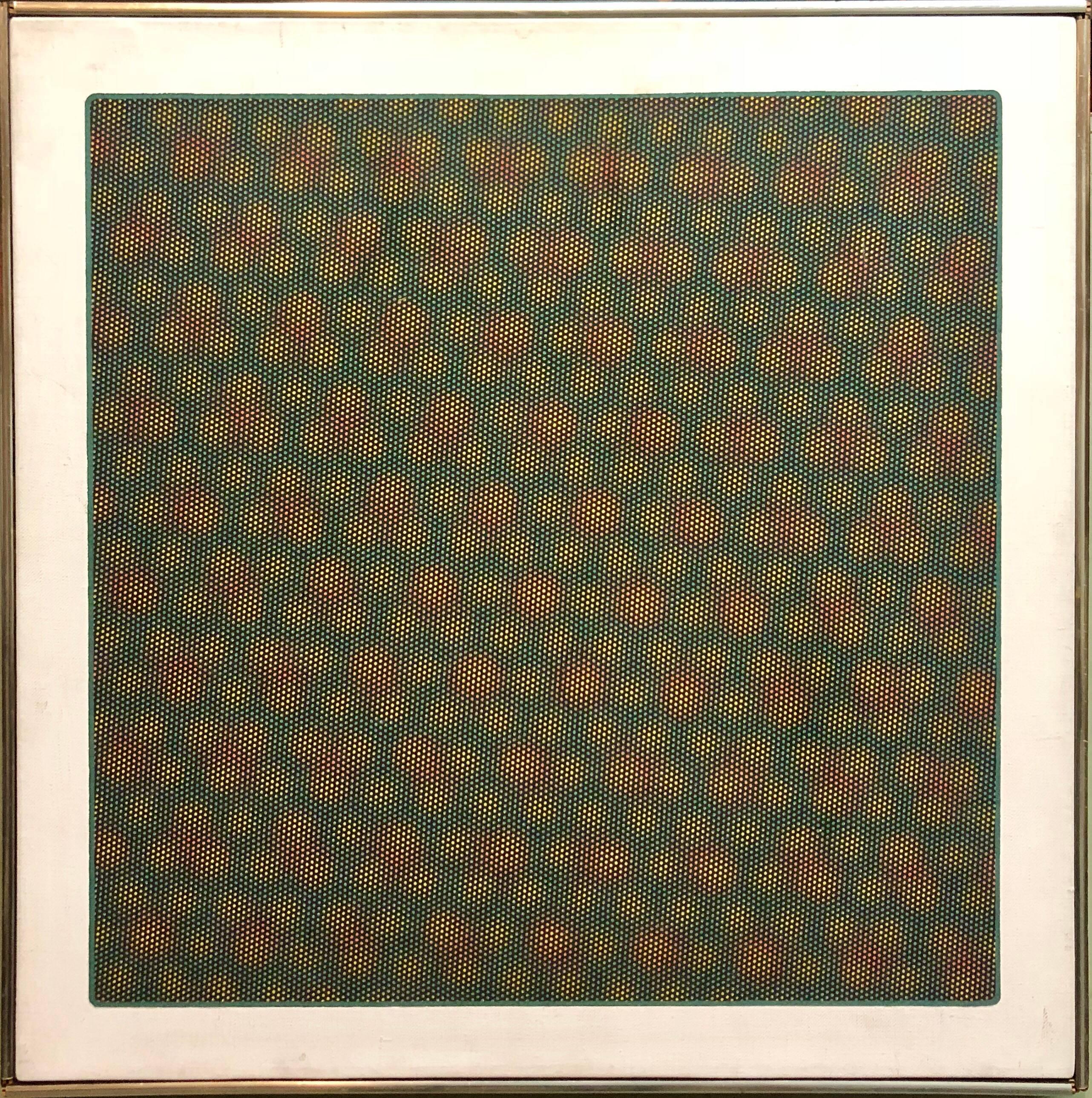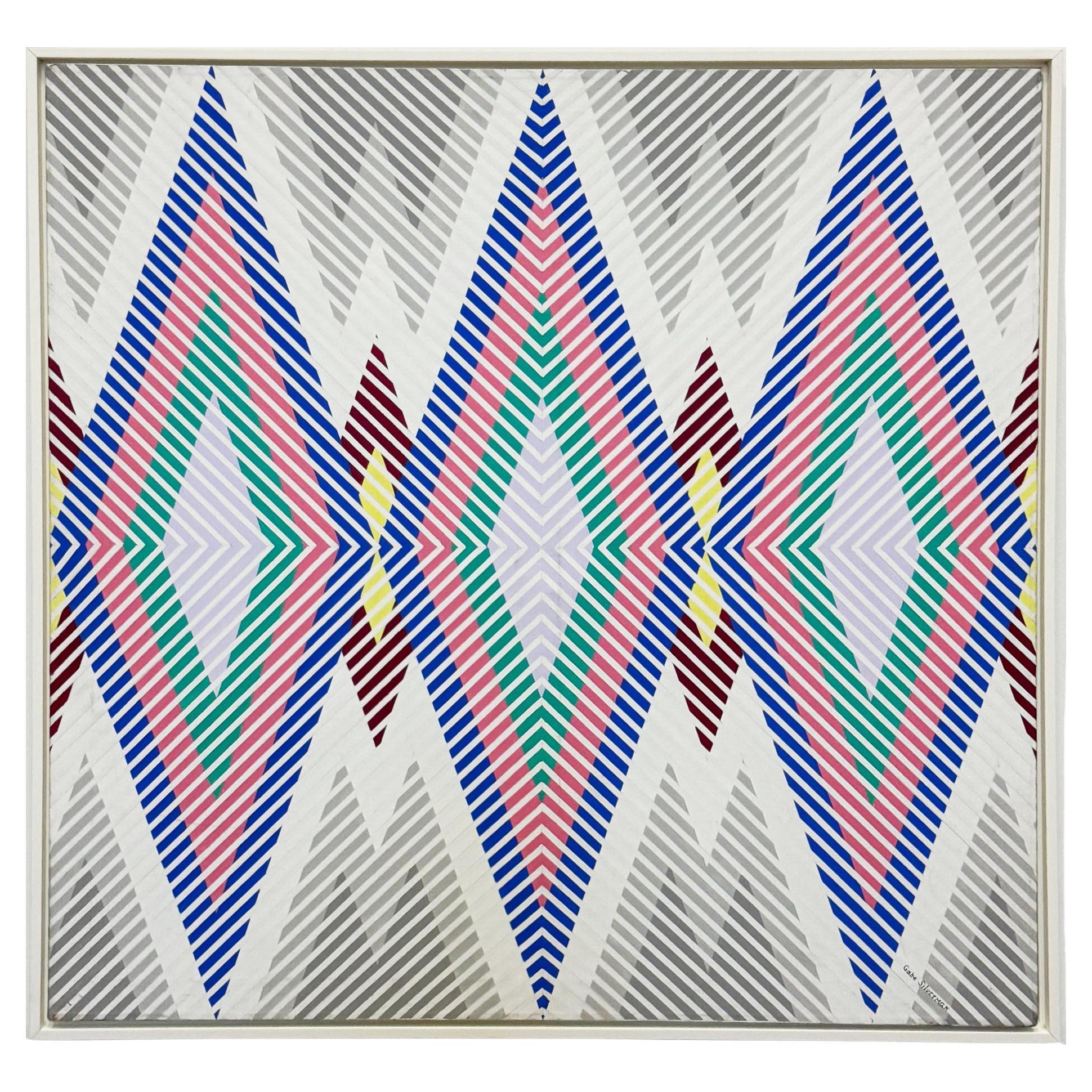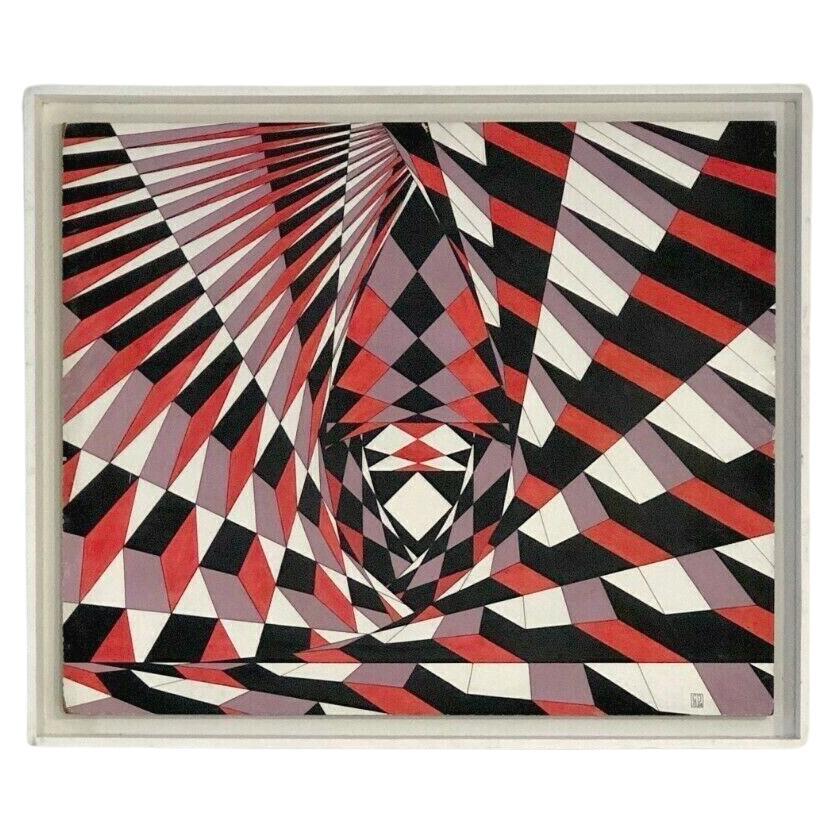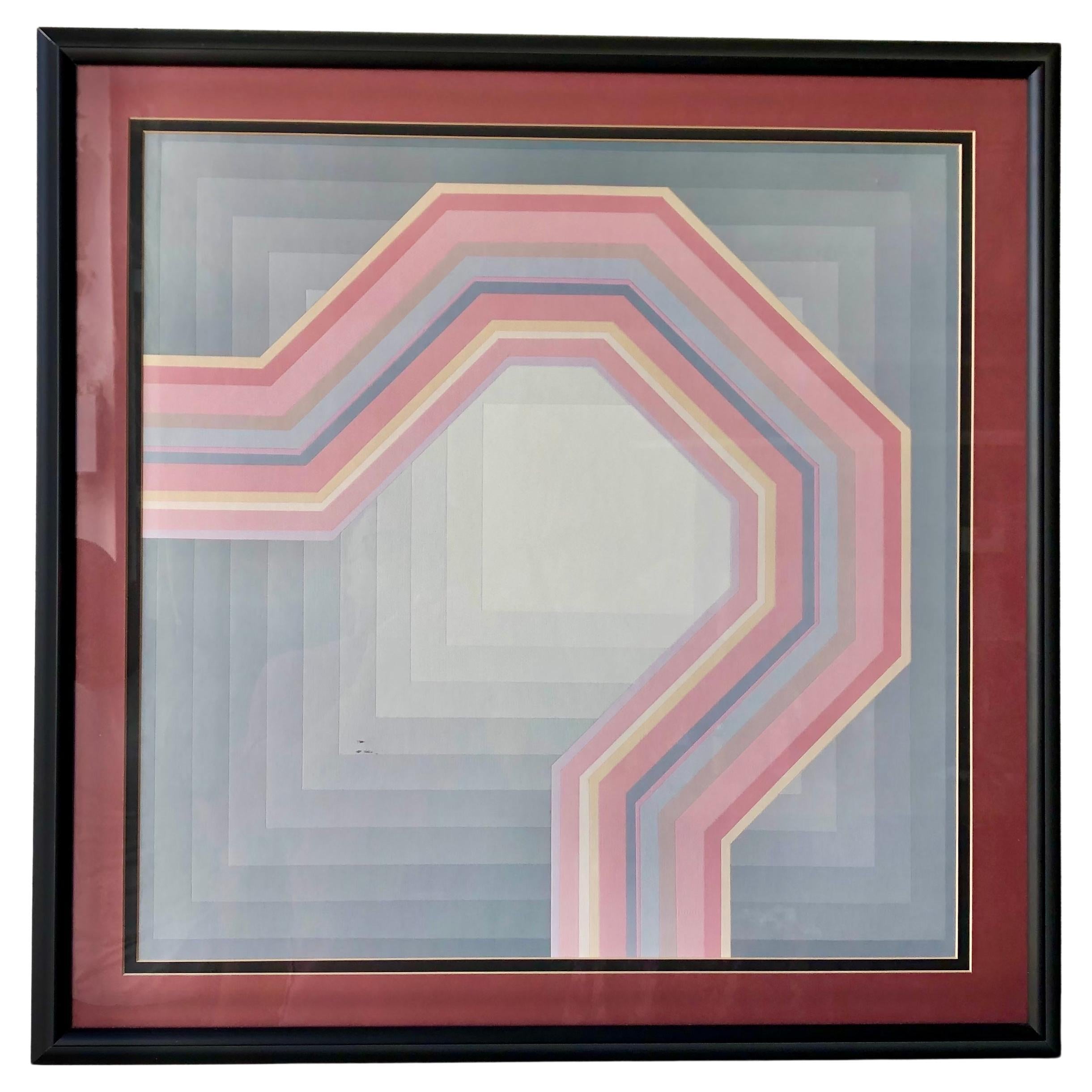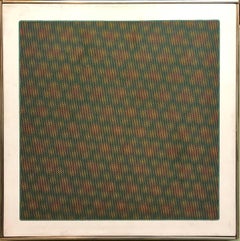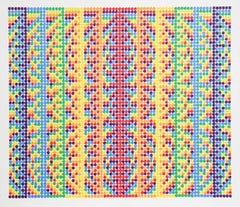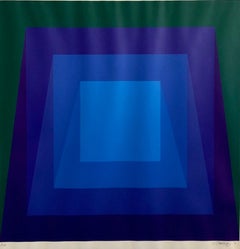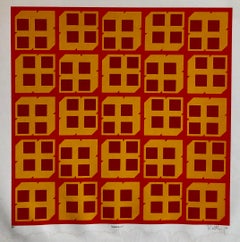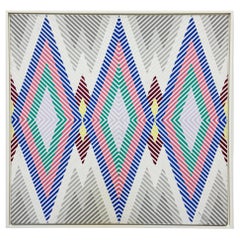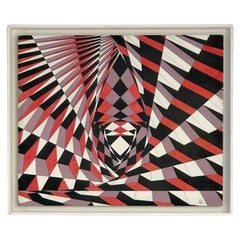Items Similar to Untitled Mod Op Art 1967 Painting on Silk
Want more images or videos?
Request additional images or videos from the seller
1 of 5
Henry PearsonUntitled Mod Op Art 1967 Painting on Silk1967
1967
$1,100
£838.02
€956.38
CA$1,545.76
A$1,684.61
CHF 892.07
MX$20,233.90
NOK 11,293.83
SEK 10,383.56
DKK 7,143.07
About the Item
Label from Obelisk Gallery verso.
Henry C. Pearson (October 8, 1914 – December 3, 2006) was an American abstract and modernist painter. Pearson was born in Kinston, North Carolina, graduated from the University of North Carolina in 1938, and studied theatrical design at Yale University. He served in the U.S. Army Air Corps in the Second World War, designing maps for the Okinawa campaign, and then re-enlisted to serve in the US occupation of Japan, where he was influenced by Japanese art and theatre forms. Henry Pearson is perhaps best known for a mildly optical manner of painting, featuring a mutable labyrinth of undulating parallel lines, which somewhat inadvertently linked him to the Op Art movement of the 1960s. Although included in the Museum of Modern Art's landmark exhibition The Responsive Eye in 1965, his work displays an intuitive rhythm and poetic elegance that falls well outside of the calculated, often hard-edged quality normally associated with the Op group of artists.
Pearson came late to the visual arts. His first career, in theatre design, was cut short by the Second World War. He entered the U.S. Army in 1942, and at war's end requested duty in occupied Japan, where a prolonged contact with Japanese culture nurtured a passion for painting. Upon his discharge from the army, in 1953, he enrolled in the Art Students League in New York City, where he studied with, among others, Reginald Marsh and Will Barnet. Inspired by Malevich, he turned to rectilinear abstraction, and employed it as the dominant means of expression in his painting between 1954 and 1961.
As early as 1959, however, sensing an incipient decadence in his geometric canvases, Pearson began to develop a new direction in his work. During the war, he served for a year in Culver City, California, where his interpretive drawings of secret imperial maps were employed to construct three-dimensional scale models of the Japanese islands. Recalling the hypnotic movement of those earlier efforts, he produced a series of exploratory sketches, first in pencil and then in ink, which over a period of several years gradually transformed illusionary mountains and valleys into purely non-objective exercises. By 1961 these drawings, reflecting a personal vision now well removed from any topographical transcription, heralded a new era of linear abstraction in Pearson's work. Quickly celebrated as well on canvas and in print, the idea became central to his oeuvre for the next fifteen years, a period which coincided with his rise to some prominence in the New York art world.Moving to New York in the early 1950s, he studied at the Art Students League of New York with Reginald Marsh and Will Barnet; he remained friends with Barnet for the remainder of his life. Pearson was loosely associated with the Op Art movement and the famous Responsive Eye exhibition at the Museum of Modern Art in 1965. Other influences were Piet Mondrian and Kasimir Malevich.
Pearson was known for abstract, multi-colored globes; 'stochastic' or chance-generated paintings; paintings modeled on Dogon (West African) sculpture; as well as paintings based on the map work he did in the army. In general, his mode was hard-edged abstraction, although not without traces of humor and whimsy. His works are in the collections of the Metropolitan Museum of Art, the Museum of Modern Art, and the North Carolina Museum of Art.
He taught at The New School for General Studies and the Pennsylvania Academy of Fine Arts for many years.
Pearson was also greatly interested in literature and illustrated several poems by the Irish Nobel Prize–winning poet Seamus Heaney. His correspondence with Heaney, and his comprehensive collection of Heaney books, manuscripts and memorabilia, is now housed at the University of North Carolina.
Pearson died in 2006.
Mr. Pearson’s work is in the collections of many museums including the
Metropolitan Museum of Art, the Museum of Modern Art, the Whitney Museum of American Art, the Guggenheim Museum, the National Gallery of Art and the North Carolina Museum of Art.
- Creator:Henry Pearson (1914 - 2006)
- Creation Year:1967
- Dimensions:Height: 12.5 in (31.75 cm)Width: 12.5 in (31.75 cm)
- Medium:
- Movement & Style:
- Period:
- Condition:needs new frame. sold unframed.
- Gallery Location:Surfside, FL
- Reference Number:1stDibs: LU38211802412
About the Seller
4.9
Platinum Seller
Premium sellers with a 4.7+ rating and 24-hour response times
Established in 1995
1stDibs seller since 2014
1,843 sales on 1stDibs
Typical response time: 1 hour
- ShippingRetrieving quote...Shipping from: Surfside, FL
- Return Policy
More From This Seller
View AllOp Art 1971 Kinetic Oil Painting Pop Art Artist
By Josef Levi
Located in Surfside, FL
Josef Alan Levi (1938) is an American artist whose works range over a number of different styles, but which are unified by certain themes consistently present among them. Josef Levi began his artistic career in the 1960s and early '70s, producing highly abstract and very modernist pieces: these employing exotic materials such as light fixtures and metallic parts. By 1975, Levy had transitioned to painting and drawing still lifes. At first these were, traditionally, of mundane subjects. Later, he would depict images from art history, including figures originally created by the Old Masters. Around 1980, he made another important shift, this time toward creating highly precise, though subtly altered reproductions of pairs of female faces which were originally produced by other artists. It is perhaps this work for which he is most well known. Since around 2000, Josef Levi has changed the style of his work yet again: now he works entirely with computers, using digital techniques to abstract greatly from art history, and also from other sources.
Levi's works of art in the collections of the Museum of Modern Art, NYC, the National Gallery of Art, and the Albright-Knox Museum, among many others. Levi's art has been featured on the cover of Harper's Magazine twice, once in June 1987, and once in May 1997.
Josef Levi received a Bachelor of Arts degree in 1959 from the University of Connecticut, where he majored in fine arts and minored in literature. From 1959 to 1960, he served to a first lieutenant in the U.S. Army, and from 1960 through 1967 he was in the U.S. Army Reserves.
In 1966, he received the Purchase Award from the University of Illinois in 1966, and he was featured in New Talent U.S.A. by Art in America. He was an artist in residence at Appalachian State University in 1969, taught at Farleigh Dickenson University in 1971 and was a visiting professor of art at Pennsylvania State University in 1977. From 1975 to 2007, Levi resided in New York City. He now lives in an apartment in Rome, where he is able to paint with natural light as he was unable in New York.
From 1959 to 1960, Josef took some courses of Howard McParlin Davis and Meyer Schapiro at Columbia University which initiated him into the techniques of reproducing the works of the Old Masters. His first works, created in the 1960s, were wood and stone sculptures of women. His first mature works were abstract pieces, constructed of electric lights and steel.
In 1970, Levi's materials included fluorescent light bulbs, Rust-Oleum and perforated metal in addition to paint and canvas.
By 1980, Josef Levi's art had transformed into a very specific form: a combination of reproductions of female faces which were originally depicted by other artists. The faces which he reproduces may be derived from either portraits or from small portions of much larger works; they are taken from paintings of the Old Masters, Japanese ukiyo-e, and 20th-century art. Artists from whom he has borrowed include: Vermeer, Rembrandt, Piero della Francesca, Botero, Matisse, Utamaro, Correggio, Da Vinci, Picasso, Chuck Close, Max Beckmann, Pisanello, Lichtenstein. The creation of these works is informed by Levi's knowledge and study of art history.
Josef Levi's paintings from this period are drawn, then painted on fine linen canvas on wooden stretchers. The canvas is coated with twenty-five layers of gesso in order to produce a smooth surface on which to work. The drawing phase takes at least one month. Levi seals the drawing with acrylic varnish, and then he may apply layers of transparent acrylic in order to approximate the look of old paintings. After the last paint is applied, another layer of acrylic varnish is sprayed on to protect the work.
Most of the figures in his contemporary pieces are not paired with any others.
SELECTED COLLECTIONS
MUSEUM OF MODERN ART, NEW YORK, NY
ALBRIGHT- KNOX GALLERY, BUFFALO, NY
ALDRICH MUSEUM OF CONTEMPORARY ART, RIDGEFIELD, CT
NATIONAL GALLERY OF ART, WASHINGTON, DC
BROOKLYN MUSEUM OF ART, BROOKLYN, NY
SMITHSONIAN NATIONAL MUSEUM OF AMERICAN HISTORY, WASHINGTON, DC
CORCORAN GALLERY, WASHINGTON, DC
UNIVERSITY OF NOTRE DAME ART...
Category
1970s Op Art Abstract Paintings
Materials
Canvas, Oil
Op Art, Kinetic 1970s Original Vintage Silkscreen Lithograph Print
By David Roth
Located in Surfside, FL
Hand signed and numbered limited edition print.
David Roth studied at the Illinois Institute of Technology's Institute of Design and was twice the recipient of the Moholy-Nagy Scholarship in visual design. It was Roth's initial work as a designer at fine art for commercial use that brought him interesting positions as art director for Lanvin, Charles at the Ritz, and Germain Monteil.
. The strings are tied in bunches and closely hung tram a wooden bar. The size and shape of the string is similar to that at a canvas painting. Each bundle is represented by a vertical row at squares on the graph and the groupings at string are lined up along the wall according to the horizontal rows at the program. The six primary and secondary colors are used in their full intensity along with black, grey, and white.
As a painter Roth works to formulate with color. Some painters regard color as a concomitant of form, hence a subordinate, but Roth's color is the chief medium of his pictorial language. A programmed juxtaposition at primary color allows Roth and the viewer to play upon various combinations. The graphs Roth executes are proportioned according to a strict mathematical formula - the pictures are
Composed according to horizontal and vertical divisions on the graph paper. The optical quality of color, deliberately sought, has its roots in the Bauhaus investigations of illusion, and thus has a direct relationship to the Op art produced in postwar Europe. Roth has arranged his hues so as to persuade the planes to separate from the ground on which they are planted, and float free in space. It is almost as if Roth is giving us a "readout" on his creative process. Although the graphs appear to vary in their use of color the same colors are used throughout, also the same amount of color. Roth's work illustrates the sophistication of the human eye-brain relationship that has developed and invites the viewer to participate in the evolution at visionary ideas.
One Man Shows
1966 The Gallery Upstairs, Buffalo, New York
1967 The Gallery Upstairs, Buffalo, New York
1969 The House of Graphics, New York
1969 Illinois Institute of Technology, Chicago, Illinois
1972 Robert Elkon Gallery, New York
1973 Robert Elkon Gallery, New York
1974 Robert Elkon Gallery, New York
1975 Michael Wyman Gallery, Chicago
1975 Robert Elkon Gallery, New York
1976 G.W. Einstein, New York
1976 Robert Elkon Gallery, New York
1977 Robert Elkon Gallery, New York
1977 G.W. Einstein, New York
1978 Sunne Savage Gallery, Boston, Massachusetts
1978 Robert Elkon Gallery, New York
1979 Nancy Roth Gallery, Katonah, New York
Group Exhibitions
1967 State University of New York, Buffalo
1970 Ronald Feldman Gallery
1970 The Everyman Gallery
1971 Robert Elkon Gallery, New York
1972 The Brooklyn Museum, New York
1972 The Newark Museum, New Jersey
1972 Art...
Category
1970s Op Art Abstract Prints
Materials
Screen
1970's Op Art Cintique Geometric Abstract Color Gradations Silkscreen Domberger
Located in Surfside, FL
Silkscreen serigraph Op art print.
Luitpold Domberger (1912-2005 ) was a pioneer of artistic screen printing in Germany.
Luitpold (Poldi) Domberger...
Category
1970s Op Art Abstract Prints
Materials
Screen
Abstract Geometric 1970s Kinetic Silkscreen Screen Print Manner Vasarely Op Art
By Paul M. Levy
Located in Surfside, FL
Paul Levy (American, b. 1944) An established designer and illustrator, Paul M. Levy was born in Brooklyn, New York, in 1944. He received his B.S. in Industrial Design from the Univer...
Category
1970s Abstract Geometric Abstract Prints
Materials
Screen
Square Variables XI
By Todd Smith
Located in Surfside, FL
Early graphic work by the photographer Todd Smith during his period at Pratt Institute in the early 1970s. Edition of 250, unsigned and unnumbered, as issued.
Category
1970s Op Art Abstract Prints
Materials
Lithograph
1970's Enamel Metal Vasarely Silkscreen Screenprint Axo Kinetic Op Art Sculpture
By Victor Vasarely
Located in Surfside, FL
Victor Vasarely (1908-1997)
Axo
This piece is hand signed and numbered
circa 1972-1977
I have seen it described as enamel on steel and enamel on aluminium. it is a serigraph on meta...
Category
1970s Op Art Abstract Paintings
Materials
Metal, Enamel
You May Also Like
Allegro, Op Art Serigraph by Roy Ahlgren
By Roy Ahlgren
Located in Long Island City, NY
Artist: Roy Ahlgren, American (1927 - 2011)
Title: Allegro
Year: 1986
Medium: Serigraph, signed and numbered in pencil
Edition: 23/100
Image Size: 18 x 25.5 inches
Size: 22.5 x 30 in...
Category
1980s Op Art Abstract Prints
Materials
Screen
Gabe Silverman 1980s Abstract Op Art Painting on Canvas, Newly Framed
Located in Miami, FL
Gabe Silverman 1980s Abstract Op Art Painting on Canvas, Newly Framed
Offered for sale is an oversized original Op Art painting recently discovered in a time capsule from the 19...
Category
Vintage 1980s American Modern Paintings
Materials
Canvas, Wood, Paint
An OPTICAL POP OP-ART KINETIC PAINTING on Panel by GUY POUPPEZ, France 1968
By Guy Pouppez De Kettenis De Hollaeken
Located in PARIS, FR
An authentic kinetic painting, Post-Modernist, Abstract Geometric, Op-Art, composition of red, purple and black geometric shapes on panel in its original American box in white lacque...
Category
Vintage 1960s European Kinetic Paintings
Materials
Wood, Paint
Sky Light XXIII, Geometric Abstract OP Art Screenprint by Evelyn B. Johnson
By Evelyn B. Johnson
Located in Long Island City, NY
This abstract screenprint was created in 1981 by American Optical artist Evelyn B. Johnson. It is signed and numbered 17/25 in pencil, and the plate size is 25.5 x 25.5 inches. It is...
Category
1980s Op Art Abstract Prints
Materials
Screen
Framed Geometric Op Art Lithograph in the Richard Anuszkiewicz's Style. C 1980s
By Richard Anuszkiewicz
Located in Miami, FL
Framed Geometric Op Art Lithograph in the Richard Anuszkiewicz's Style . Circa 1980s
Features a geometric figure that successfully combines the 1980s Pastel...
Category
Vintage 1980s American Post-Modern Decorative Art
Materials
Aluminum
Aztec, Op Art Geometric Abstract Screenprint by Roy Ahlgren
By Roy Ahlgren
Located in Long Island City, NY
Artist: Roy Ahlgren, American (1927 - 2011)
Title: Aztec
Year: 1983
Medium: Screenprint, signed and numbered in pencil
Edition: 150
Image Size: 18 x 26 inches
Size: 22.5 x 30 in. (57...
Category
1980s Op Art Abstract Prints
Materials
Screen
